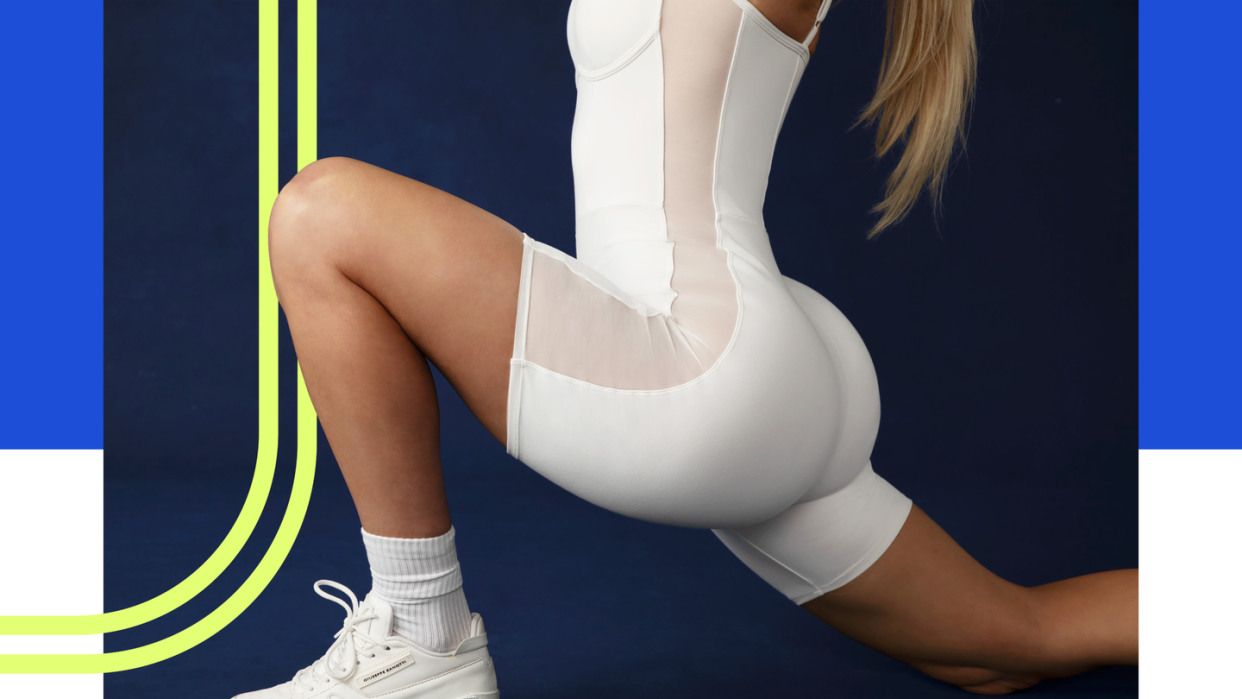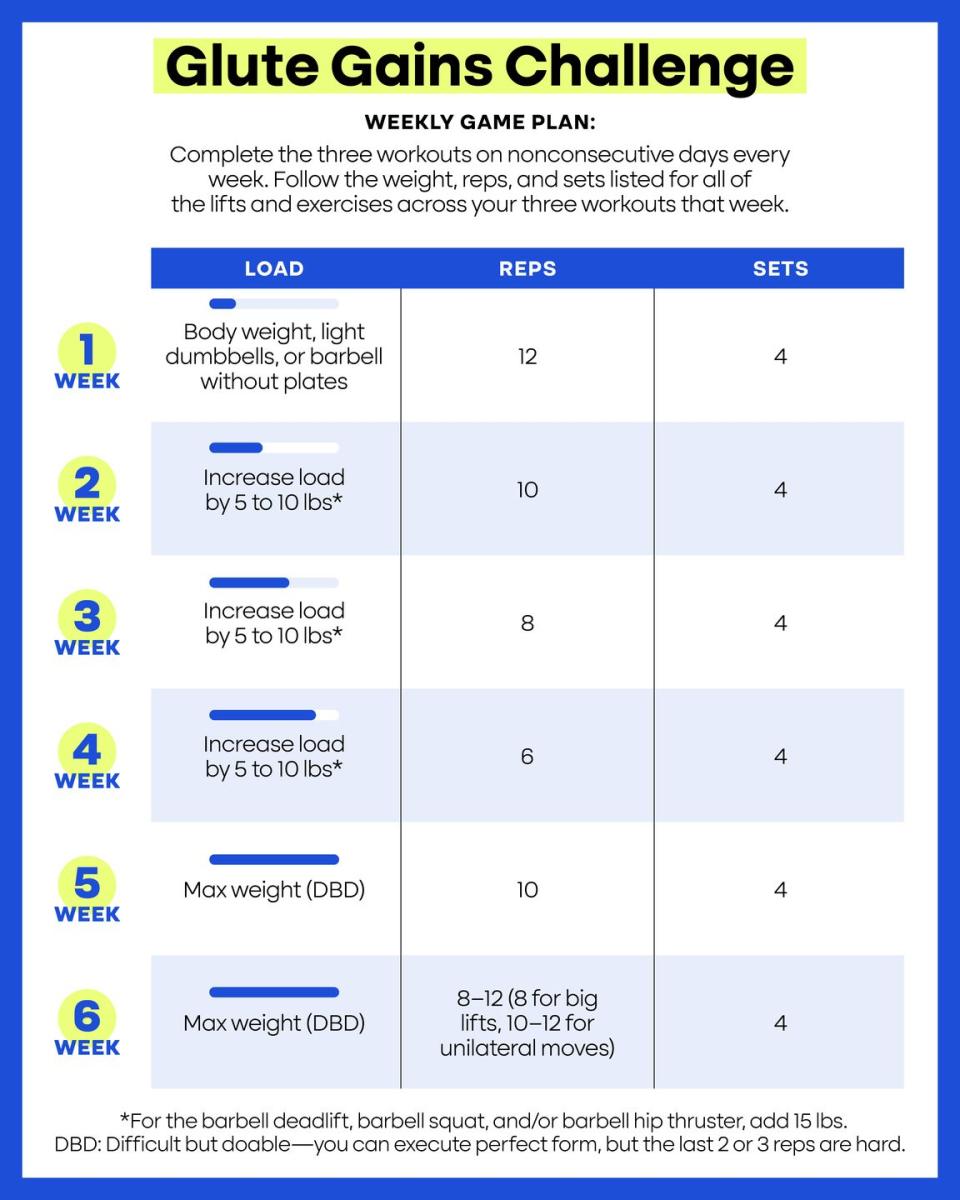This Squat-Focused Lower-Body Workout Will Help You See Serious Glute Gains

Workout 1 of the WH Glute Gains Challenge is designed to open up your hip flexors to ensure full range of motion (ROM) when you do nonnegotiable butt exercises like squats. Get ready for the deepest and most effective squats of your life.
Fitness fact: If you want to build your glutes and grow your booty, you have to move your glute muscles through their complete range of motion when doing the exercises. Proper ROM means that you are able to expand and contract the muscle and surrounding tendons and ligaments to their fullest extent, leading to gains.
Created by Sandy Brockman, CPT, this workout combines classic booty moves such as the back squat and Bulgarian split squat and helps correct and strengthen lower-body muscle imbalances, in turn creating stronger glutes efficiently, says Brockman.
Keep reading for all the details on this session—the first of three strength workouts that make up Brockman’s exclusive training plan.
Meet the expert: Sandy Brockman is a certified personal trainer at Kollective in Austin, Texas. She helps women build muscle and transform their bodies and health through strength training with a focus on glutes.

Workout 1
INSTRUCTIONS: Complete three rounds of the warm-up exercises in order with as little rest as possible between moves and sets. (This should take you approximately five minutes.) Then move through the exercises in Lift A, with little to no rest between moves, repeating the Lift A circuit for four rounds, including the corrective. Then move on to Lift B and complete in the same fashion. Consult the chart below for each week’s rep scheme and suggested weight.
Workout 1 Cheat Sheet:
Warm-Up (3 rounds):
Air Squat, 10 reps
Jump Squat, 5 reps
Reverse Lunge, 5 reps alternating
Butterfly Situp, 5 reps
Plank, 30 second hold
Couch Stretch with Activation, 30 seconds each side
Lift A (4 rounds, 6 - 12 reps each based on chart below):
Back Squat
Bulgarian Split Squat
Couch Stretch with Activation, 30 seconds each side
Lift B (4 rounds, 6 - 12 reps each based on chart below):
RDL
Pigeon Stretch with Activation, 1 minute hold each side
TIME: 45–60 minutes
EQUIPMENT: Mat, box or bench, dumbbells and/or barbell with weight plates, clips, squat rack
How To Choose The Right Weight
The key to success is following Brockman’s DBD protocol: The weight you select should feel Difficult But Doable. If you’re a beginner and have no idea where to start, Brockman suggests going with a 35-pound barbell (which is the skinnier barbell with no weight plates) and/or 5- to 10-pound dumbbells. Then try to go up in weight week over week. A rule of thumb to keep in mind? If you feel you can go heavier without sacrificing form, you should.

[image] stripped
WARM-UP: Air Squat

How to:
Stand with feet shoulder-width apart with pelvis tucked, glutes squeezed, and arms at sides.
Initiate a squat by engaging glutes and hinging at hips as you clasp hands in front of chest, descending until hips are parallel (or slightly lower than parallel) to floor.
Immediately reverse movement to return to start. That’s 1 rep. Do 10 reps.
WARM-UP: Jump Squat

How to:
Stand with feet shoulder-width apart with pelvis tucked, glutes squeezed, and arms at sides.
Initiate a squat by engaging glutes and hinging at hips as you bring hands to clasp in front of chest.
Immediately jump up into the air, bringing arms behind you. That’s 1 rep. Do 5 reps.
WARM-UP: Reverse Lunge

How to:
Stand with feet hip-width apart with pelvis tucked, glutes squeezed, and hands clasped in front of chest.
Step left leg back into a lunge, then immediately step back to starting position.
Step right leg back into a lunge, then return to start. That’s 1 rep. Continue alternating for 5 total reps.
WARM-UP: Butterfly Sit-Up

How to:
Lie on back and touch soles of feet together in a “butterfly” position.
Extend arms behind head so fingers touch floor.
Engage core as you sit up and touch toes, then immediately return to start. That’s 1 rep. Do 5 reps.
WARM-UP: Plank

How to:
Start in a plank position, weight resting on forearms and toes, knees touching floor.
Pull up through core to bring knees off floor and hold for 30 seconds. That’s 1 set.
WARM-UP: Couch Stretch With Activation

How to:
Kneel on floor facing away from bench (or couch), knees on pad or rolled-up mat. Bring left leg forward to a low lunge position, then draw lower right leg up against bench, toes pointing up.
Squeeze right glute, then release. Continue squeezing and releasing for 30 seconds, then repeat on other side.
LIFT A: Back Squat

How to:
Set up squat rack with desired weight, or use just the bar. (Option: Swap barbell for a set of dumbbells).
Place barbell on upper back or dumbbells on shoulders.
Step a few feet back, tuck pelvis, squeeze glutes, and descend for 3 seconds into a squat until glutes are slightly below parallel.
Squeeze glutes to come back up to standing. That’s 1 rep.
Complete all reps, then walk bar back to rack.
LIFT A: Bulgarian Split Squat

How to:
Stand 3 to 4 feet in front of bench or box with barbell loaded on upper back or a dumbbell in each hand at sides.
Bring left foot to rest on bench behind you, keeping hips pointing straight ahead.
Engage glutes, tuck pelvis, and lower down for 3 seconds, bringing left knee as close to floor as possible. Think about tipping torso forward (nose over toes) as you push hip of right leg back as far as it can go.
Keep glutes squeezed and push through right heel to reverse movement to return to start. That’s 1 rep. Do all reps on one side before switching.
LIFT A CORRECTIVE: Couch Stretch With Activation

How to:
Kneel on floor facing away from bench (or couch), knees on pad or rolled-up mat. Bring left leg forward to a low lunge position, then draw lower right leg up against bench, toes pointing up.
Squeeze right glute, then release. Continue squeezing and releasing for 30 seconds, then repeat on other side.
LIFT B: RDL

How to:
Stand with feet shoulder-width apart, holding a dumbbell in each hand in front of thighs.
Engage glutes, push hips back, and bend knees very slightly as you simultaneously lower torso and allow dumbbells to track down thighs in a 3-second descent until they reach shins.
Squeeze glutes to immediately reverse movement to return to start. That’s 1 rep. Do all reps on one side before switching.
Pro tip: Keep your chest up and “proud” and squeeze shoulder blades together throughout the movement.
LIFT B CORRECTIVE: Pigeon Stretch With Activation

How to:
Sit on floor with right leg bent at 90 degrees, left leg straight out behind body with top of foot facing down. Place hands on floor in front of you.
Push left leg into floor as you squeeze and release left glute while simultaneously stretching right glute. Continue for 1 minute, then repeat on other side.

What To Focus On Week By Week
Week 1: Volume And Form
Keep the weights light enough (or use body weight) so you can complete 12 reps of each move. “By going lighter with more reps the first week, you can focus on both your form and getting your body prepared for going heavier as the weeks progress,” says Brockman.
Week 2: Volume, Form, And Hypertrophy
This week, you drop to 10 reps per move, so you should be able to lift heavier (or add weights if you used your body weight in week one). “By reducing the reps in the second week and adding weight, we are starting to really get into hypertrophy, which means muscle growth,” says Brockman.
Week 3: Pure Strength
Drop the reps again so you can really amp up your load and move into max strength-building territory, which will help you build up the power to support hypertrophy when you cycle back to it in a couple of weeks. “This follows the traditional progressive-overload principle of strength training,” says Brockman. (FYI: Six to eight reps with heavy weight is traditionally considered best for strength gains; 10 to 12 reps is ideal for hypertrophy.)
Week 4: Pure Strength
This week we are at the peak of the strength cycle, says Brockman. You may not need to count seconds during the eccentric portions of your lifts (when the muscle elongates and lengthens under load) this week since your body should be programmed to move in a slow and controlled way thanks to all that practice in earlier weeks.
Week 5: Volume, Strength, And Hypertrophy
Now you’re pivoting back up to medium volume (10 reps per exercise at a lighter weight than last week). “Having peaked at four weeks of our strength cycle, we now go back to more hypertrophy rep ranges,” says Brockman.
Week 6: Strength And Volume
“Week six is now a combo of our strength and hypertrophy,” says Brockman. “We’re going with lower reps but heavier weight on our bigger lifts—squats and deadlifts—and lighter weight with more volume for our unilateral moves, creating a perfect hybrid of both to complete the six-week cycle,” she explains.

You Might Also Like

 Yahoo Lifestyle
Yahoo Lifestyle 
